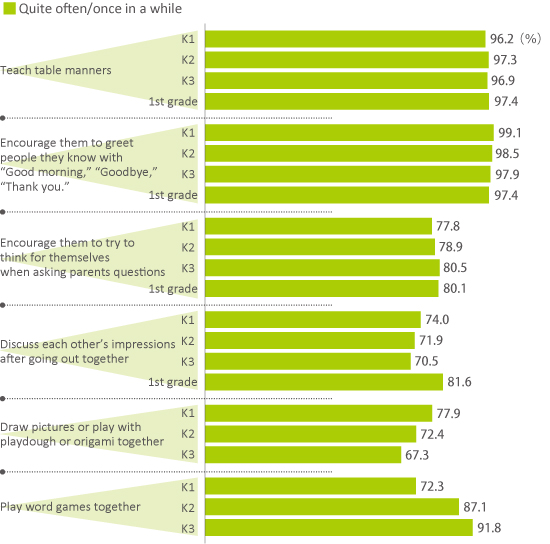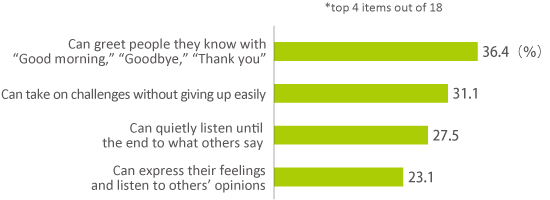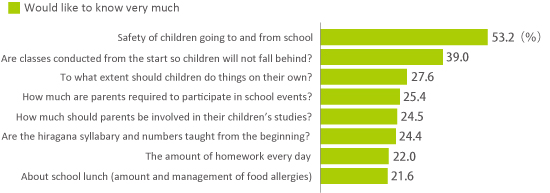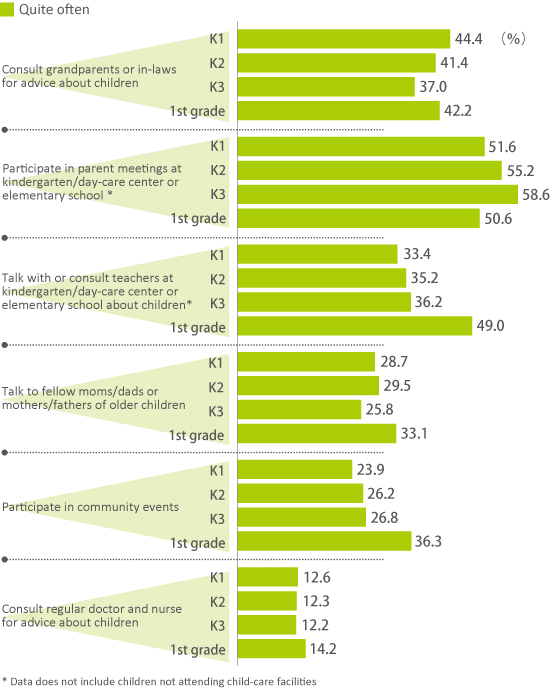- Survey background / Survey overview / Basic attributes of samples
- Chapter 1. Development of Children's Learning Attitude
- Chapter 2. Parents' Involvement in Children's Learning (This article)
- Chapter 3. Essential Factors to Cultivate Learning
- Comments on the Survey Report on Home Education from Early Childhood to First Grade in Elementary School
Encouragement from Parents
Regarding parents' involvement at home, the results indicate that the way parents take part in home learning changed as the child grew older. For example, parents played with playdough, origami (folding paper to make various objects) and did word games with children according to their age. On the other hand, not much difference could be seen in how parents encourage children to learn daily habits or cultivate learning attitudes according to the child's age.
How often do you do the following with your child (children) daily?
Figure 2-1: Encouragement from parents at home (K1 to first grade)

As shown in Figure 2-1, the percentage of parents who play with their children using playdough or origami "quite often" or "once in a while" decreased as the child grew older--77.9% of the parents played with their children in K1, 72.4% of them played with their K2 children, and 67.3% of them played with their K3 children. On the other hand, parents who played word games with their children increased with the child's age, amounting over 90% of the mothers with K3 children--72.3% of mothers with K1 children, 87.1% of mothers with K2 children, and 91.8% of mothers with K3 children. A high percentage of parents, more than 96%, answered they encouraged their children to mind their table manners or greet people, regardless of their children's age. Meanwhile, regardless of the children's age, about 80% of parents encourage them to try to think for themselves when they ask questions.
Parents Reading Picture Books or Books to Children Aloud
The frequency of parents reading picture books or books with children was highest among K1 children, and lowest among K3 children. In addition, the more frequently the parents read aloud to children when in K1, the more frequently children read picture books or books on their own later on.
Q. How often do you usually read aloud picture books or books to your child?
Figure 2-2: Frequency of reading picture books/books together

Q. How often does your child read (or look at) picture books or books on his/her own?
Figure 2-3: Frequency of children reading books/picture books on their own (by frequency of parents reading aloud to K1 children)

As in Figure 2-2, the percentage of parents who read to their children "almost every day" decreased as the child's age increased (27.2% of parents with K1 children, 21.8% with K2 children, 13.9% with K3 children). As shown in Fig. 2-3, 55.5% of K1 children whose parents read to them aloud "almost every day" read or look at picture books/books on their own, while 25.8% of those whose parents read aloud to them "1-2 days a week" read on their own, and 20.9% of those whose parents read aloud to them "less than 1-3 days a month" read on their own. This shows that the more frequently parents read aloud to their children, the more children take the initiative to read or look at picture books or books on their own.
Comments from the Research Group--Reading Books and Picture Books Aloud to Children
Picture books or books open a door to a whole new world for children, providing them with opportunities to reflect on and review everyday experiences in depth. In addition, children can experience the joy of sharing the worldview of the books with others through reading aloud. As a matter of course, reading aloud serves as the gateway to "reading and writing," which becomes the focus in elementary school, as well as a good opportunity to become familiar with natural science and other fields, besides stories.
When reading aloud to children, a good rule is to focus "80% on watching the child and 20% on reading aloud." Parents should enjoy reading aloud to their children while also observing their expression and how they look when absorbed in the book. As children reach early childhood, they will start to think on their own. As children get older, parents should read the book in a matter-of-fact tone, and respond to questions and requests to read the passage again in order to support their thinking process. Thus, by having their parents to read to them, children think by themselves through picture books and books, and this becomes a foundation for cultural appreciation on a wider scale.
Preparing for Elementary School
Reflecting on the early childhood years of their children, when asked what daily habits and attitudes of learning to learn they wanted them to acquire, most parents of first graders answered that they wanted their children to be willing to take on challenges and to be able to listen to others in addition to making daily greetings and expressing gratitude. In the hiragana/numeracy/logical-thinking category, most parents cited being able to hold a pencil properly or to read the Japanese hiragana syllabary, which are both everyday skills necessary for elementary school learning.
Q. Looking back now, what abilities do you think your child should have acquired before entering elementary school? (Choose up to three items)
Figure 2-4: Daily habits, attitudes of learning to learn (looking back from first grade)

Figure 2-5: Hiragana/Numeracy/Logical Thinking (looking back from first grade)

Comments from the Research Group--Habits that Connect Early Childhood with Elementary School Learning
The results show that most parents consider greeting others and being able to hold the pencil properly as essential skills children should acquire before entering elementary school. Greeting others becomes a habit through doing so daily at home, or at child-care facilities. Holding a pencil requires practice, but doodling, playing maze puzzles, and drawing patterns may be a good way to practice having fun. Reading the hiragana syllabary can be acquired by reading picture books and trying to read whatever children notice in their surroundings. Practicing how to write carefully will help children learn how to write his/her name.
On the other hand, the fact that many parents feel that a challenging spirit and the attitude to ask questions and listen to others are important for learning, has much significance. These are the core attitudes that lead to class participation and learning at elementary school. Needless to say, these attitudes develop in early childhood through concentrating on play and communicating with adults.
Questions about Elementary School/Parents' Involvement in the Community
When asked about what they want to know about elementary school, parents of K3 children most frequently cited "safely going to and from school," "how class is conducted by teachers," and "to what extent children should do things on their own." Furthermore, when questioned whom they ask for advice, 30-40% of the parents said they ask their own parents, in-laws and teachers at child-care facilities or elementary school. The number of parents consulting teachers for advice increased from K3 to first grade.
Q. What would you like to know most about the elementary school your child will enter?
Figure 2-6: About Elementary school (K3)

Figure 2-7: Parents' involvement in the community (K1 to first grade)

Figure 2-6 shows that parents were most concerned about the "safety of children going to and from school" at 53.2%, followed by "how class is conducted" at 39.0% and "doing things on their own" at 27.6%, all concerns about daily life at elementary school. The results were possibly influenced by the fact that parents have fewer opportunities to see how children are doing at school as they go to and from school on their own, in contrast to kindergartens or day-care centers, where parents accompany them to and from and have the chance to observe their activities.
How much do parents consult others in child-rearing? Figure 2-7 shows that 30-40% of the parents consult their own parents or in-laws, and teachers at child-care facilities or elementary schools, 20-30% talk to fellow moms or people in the community, and 10% consult their regular doctor/nurse. The frequency of consulting their own parents, in-laws, teachers and fellow moms, and of participating in community events increased as children entered elementary school.














